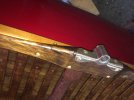Howie
Wooden Canoes are in the Blood
I have a fella who is wondering if I could add rowing hardware to one of his canoes.
I at first balked at the idea thinking that the inner rails wouldn't be able to handle the stress. But I was just reading the recent thread titled 'Grit in Paint' by GreenThumbed. In it Andre Cloutier included a pic of a canoe with what appears to be capable of being rowed. That is, there is a block of wood attached to the underside of each inner rail and what appears to be a hole in the block that goes up through the rail. See pic below:

So I'm thinking that it is possible to equip a canoe for rowing. Anybody ever done it?, or owns such a canoe? I'm finishing up restoring a 17ft Thompson Hiawatha for him. It seems to me to be a good candidate for such a mod. Where might suitable rowing hardware be obtained?
O... and I did a Google and saw this rig for sale for $85 at https://clcboats.com/shop/products/boat-gear/rowing-gear-accessories/canoe-rowing-rig.html
I at first balked at the idea thinking that the inner rails wouldn't be able to handle the stress. But I was just reading the recent thread titled 'Grit in Paint' by GreenThumbed. In it Andre Cloutier included a pic of a canoe with what appears to be capable of being rowed. That is, there is a block of wood attached to the underside of each inner rail and what appears to be a hole in the block that goes up through the rail. See pic below:
So I'm thinking that it is possible to equip a canoe for rowing. Anybody ever done it?, or owns such a canoe? I'm finishing up restoring a 17ft Thompson Hiawatha for him. It seems to me to be a good candidate for such a mod. Where might suitable rowing hardware be obtained?
O... and I did a Google and saw this rig for sale for $85 at https://clcboats.com/shop/products/boat-gear/rowing-gear-accessories/canoe-rowing-rig.html


